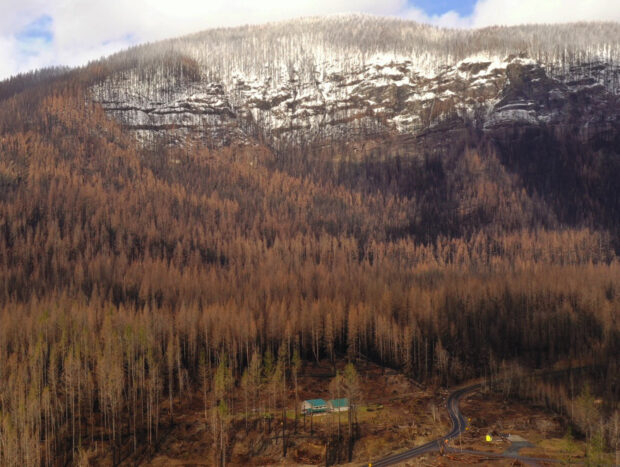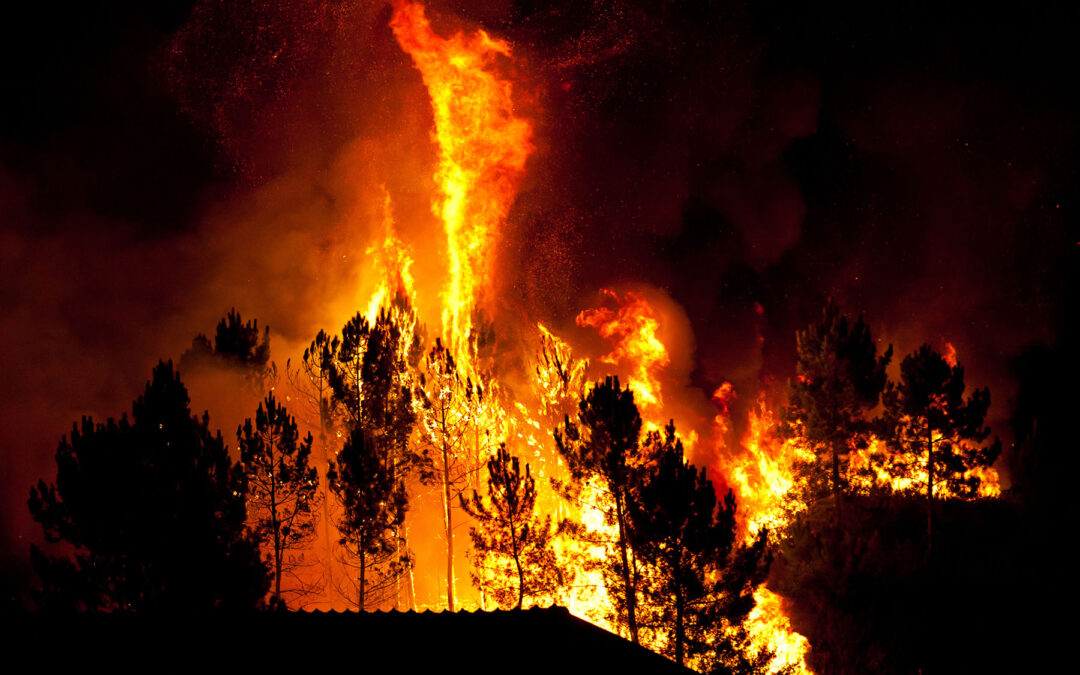While there’s no historical evidence that Nero “fiddled while Rome burned,” there’s been plenty of fiddling in our forests while homes and communities burn in the American West. Jack Cohen has not been fiddling. His decades-long research at the Forest Service Missoula Fire Sciences Lab has dispelled commonly espoused wildfire myths and demonstrates that people who reside in wildland-urban (WU) areas do not have to live in fear of losing their homes to catastrophic wildfire.
As Cohen points out, Forest Service data show that 98% of wildfires are consistently controlled before they grow large enough to become destructive to communities. National Interagency Fire Center records show that the number of fires per year has remained fairly consistent, averaging around 70,000 since 1983 when the information was first tracked. While the number of fires per year remain reasonably consistent and the percentage of uncontrolled fires holds steady at 2%, a study led by Philip Higuera shows that the destructiveness of uncontrolled fires increased by 246% over the past decade.
Examples of this increased destructiveness include the 2018 Camp Fire, which claimed 85 lives. The fire burned through thinned and clear-cut forest to incinerate over 18,000 homes and destroy the town of Paradise. In 2021, the Dixie fire burned through forests treated for fire mitigation and leveled the town of Greenville, California. In December 2021, the Marshall Fire near Boulder, Colorado, burned through grasslands to destroy more than 1,000 homes in less than 8 hours.
The numbers reveal, as Cohen states in the film Elemental: Reimagine Wildfire, “There is no management trend that indicates that we’re going to be able to control all wildfire.” Cohen concludes, “While extreme wildfires will evade control and inevitably spread to communities, WU fire disasters are not inevitable. We can effectively prevent WU fire disasters by reducing home ignitability … without necessarily controlling wildfires or altering vegetation.”

The Bradshaw home survived a massive crown fire in the 2020 Beachie Creek Fire in Oregon largely thanks to “home hardening” (photo by Ralph Bloemers, Elemental: Reimagine WIldfire).
Much of the rationale for cutting trees in the forest is based on the idea of preventing crown fires, which spread from treetop to treetop. But as Cohen’s research revealed, “More than half the time, the big crown fires aren’t igniting these structures. It’s something else. … As it turns out we’re talking about a burning ember landing on the structure and the debris that maybe is in the rain gutters and igniting that debris that then puts flame on the eaves that then spreads into the attic of the house and totally consumes the house.” And wind-driven wildfires are essentially impossible to control no matter how much fuel (i.e., trees) is removed from forests. That’s because wind can carry embers more than a mile, bypassing fuel breaks and thinned forest to start spot fires that create more embers to be spread by the wind.
Cohen’s passion for science readily translates to film as he describes the implications of his work in Elemental: “What this all means is that we have huge opportunities to change the requirements of combustion such that it doesn’t happen. We don’t have to control the extreme wildfire in order to keep the house from igniting and burning. And we don’t have to live in a concrete ammo bunker to prevent the next Paradise.”
As Cohen’s research demonstrates — along with the Camp, Dixie, and Marshall fires — forest treatments for wildfire mitigation have not been shown to save lives, homes, or communities, yet the Infrastructure Investment and Jobs Act gave the Forest Service $3 billion to accelerate forest treatments — i.e., tree cutting.
“For the sake of fiscal responsibility, scientific integrity, and effective outcomes,” Cohen told Bill Gabbert of Wildfire Today, “it’s high time we abandon the tired and disingenuous policies of our century-old all-out war on wildfire and fuel treatments conducted under the guise of protecting communities.”
Cohen’s work informs the National Fire Protection Association’s (NFPA’s) Firewise USA program, which provides practical, effective recommendations for protecting homes and communities from wildfire. The NFPA website acknowledges that “embers and small flames” are “the main way that the majority of homes ignite in wildfires,” and its Wildfire USA program stresses the importance of the Home Ignition Zone, a concept developed by Cohen.
The Home Ignition Zone is actually three zones, each of which carries different recommendations for protecting homes and communities against wildfire. The home and everything within 5 feet of any part of the structure are the Immediate Zone and the most critical for home survival. Firewise USA guidelines are explicit: “START WITH THE HOUSE ITSELF then move into the landscaping section of the Immediate Zone.” Recommendations for this zone include:
- Clean roofs and gutters of dead leaves, debris and pine needles that could be ignited by embers.
- Replace or repair any loose or missing shingles or roof tiles.
- Reduce the risk of embers passing through eave vents by installing 1/8-inch metal screening.
- Clean debris from exterior attic vents and install 1/8 inch metal screening to prevent embers blowing into attics.
- Repair or replace damaged or loose window screens and any broken windows.
- Screen or box-in areas below patios and decks with wire mesh to prevent combustible materials like leaves from accumulating.
- Move any anything that can burn away from wall exteriors — mulch, plants, leaves, needles, firewood, etc.
- Remove anything stored underneath decks or porches.
From 5 to 30 feet from the home is the Intermediate Zone. Within this zone, Firewise USA calls for “careful landscaping” that can help “decrease fire behavior.” Intermediate Zone recommendations include:
- Clear vegetation from under stationary propane tanks.
- Create fuel breaks with driveways, walkways, patios, and decks.
- Keep lawns and native grasses mowed to a height of four inches.
- Remove ladder fuels (vegetation under trees) so a surface fire cannot reach the crowns. Prune trees up to 6-10 feet from the ground (not more than a third of the overall tree height for smaller trees).
- Space trees to have a minimum of 18 feet between crowns with the distance increasing as the slope increases.
- Tree placement should be planned to ensure the mature canopy is no closer than 10 feet to the edge of the home.
- Trees and shrubs in this zone should be limited to small clusters of a few each to break up the continuity of the vegetation across the landscape.
The Extended Zone is the area 30-100 feet from the home. For this zone, Firewise USA guidelines include:
- Dispose of heavy accumulations of ground litter and debris.
- Remove dead plant material.
- Remove small conifers between mature trees.
- Remove vegetation adjacent to storage sheds or other outbuildings.
- Trees 30-60 feet from the home should have at least 12 feet between canopy tops (more if the trees are on a slope).
- Trees 60-100 feet from the home should have at least 6 feet between the canopy tops (again, more spacing for steeper slopes).
Firewise guidelines can be implemented for a single home or for an entire community, and communities of between eight and 2,500 homes can become certified as Firewise USA sites, a process that engages the entire community in a multi-year planning and implementation process. Firewise guidelines are also shaping new construction, sometimes through building code requirements, and evidence from the Aug. 9 Lahaina Fire in Maui shows that the guidelines work.
The Insurance Institute for Business and Home Safety recently published a report showing that these building codes and construction techniques were effective in saving homes from the Lahaina Fire. The report highlights a residential development of single-family homes and multifamily units that escaped destruction at least partly due to fire-resistant construction and modern building codes. While the exteriors of some buildings ignited, they were not consumed by flames. The report notes, “Hawaii’s modern building code has high-wind requirements that introduced elements that helped newer construction resist wildfire conditions.”
Even though the homes in this development were located close together, the homes did not burn. The report lists three construction traits that contributed to home survival:
- Class A roof covers (asphalt shingles and metal).
- Non-combustible exterior wall materials.
- Screened vents that prevented embers from entering the attic space.
The report also notes that the surviving neighborhood had less landscape vegetation than subdivisions that were destroyed by the fire. Less vegetation near structures meant less fuel for the flames to spread from one structure to the next.
Real-world evidence from Colorado to Hawai’i refutes the current federal funding paradigm and supports Cohen’s findings. “I have a high level of confidence,” Cohen says, “that we can prevent community fire destruction during extreme wildfires because the research that has gone on for the last 30-plus years shows us that we have opportunities to prevent the big community fire disasters. But if we continue our current emergency response approach, wildland-urban fire disasters will be inevitable. … It’s very frustrating to me to realize that Paradise didn’t have to happen and then listen to an interview of a fire professional saying there is nothing that we could have done — because there is.”


